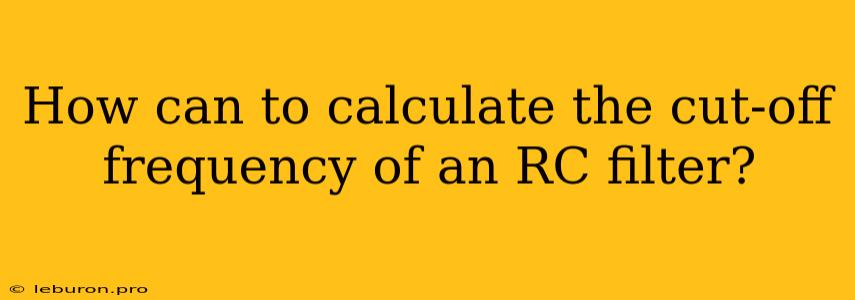How to Calculate the Cut-Off Frequency of an RC Filter
Understanding the cut-off frequency of an RC filter is crucial for designing and analyzing circuits that process signals within a specific frequency range. An RC filter, composed of a resistor (R) and a capacitor (C), acts as a frequency-selective network, allowing signals below a certain frequency to pass through while attenuating signals above that frequency. This cut-off frequency, denoted by f_c, serves as the boundary between the filter's passband and stopband. Calculating the cut-off frequency is essential to ensure the filter performs as intended for your specific application.
The Basics of RC Filters
Before delving into the calculation, let's understand the fundamentals of RC filters. They come in two main varieties:
1. Low-Pass RC Filter: This type of filter allows low-frequency signals to pass while attenuating high-frequency signals. It achieves this by utilizing the capacitor's property of impeding the flow of high-frequency currents.
2. High-Pass RC Filter: Conversely, a high-pass RC filter passes high-frequency signals while attenuating low-frequency signals. It achieves this by using the capacitor's ability to act as a short circuit for high frequencies, allowing them to pass through.
The Formula for Cut-Off Frequency
The cut-off frequency of an RC filter is calculated using the following simple formula:
f_c = 1 / (2πRC)
Where:
- f_c: Cut-off frequency in Hertz (Hz)
- R: Resistance in Ohms (Ω)
- C: Capacitance in Farads (F)
This formula signifies the frequency at which the filter's output signal power is halved, or 3 dB less than the input signal power.
Calculating Cut-Off Frequency for Different RC Filter Configurations
1. Low-Pass RC Filter:
- RC Network: Resistor (R) in series with a capacitor (C), and the output is taken across the capacitor.
- Calculation: The formula above directly applies to calculate the cut-off frequency for a low-pass filter.
2. High-Pass RC Filter:
- RC Network: Resistor (R) in series with a capacitor (C), and the output is taken across the resistor.
- Calculation: The same formula above applies to calculate the cut-off frequency for a high-pass filter.
Practical Applications of Cut-Off Frequency Calculation
The cut-off frequency calculation finds numerous applications in various fields, including:
- Audio Signal Processing: RC filters are used in audio systems to filter unwanted frequencies like high-frequency noise or low-frequency hum.
- Telecommunications: They are employed in signal conditioning circuits to eliminate unwanted noise and interference.
- Instrumentation: RC filters play a crucial role in filtering unwanted signals from sensors and measuring devices.
- Power Electronics: They are used to smooth out ripple voltage in power supplies and filter high-frequency switching noise.
Determining the Components for a Specific Cut-Off Frequency
Often, you need to design an RC filter with a specific cut-off frequency. In this case, you can rearrange the cut-off frequency formula to determine the required values of R and C:
R = 1 / (2πf_cC)
C = 1 / (2πf_cR)
By knowing the desired cut-off frequency and choosing one component value (either R or C), you can calculate the other component value to achieve the desired filter characteristics.
Example Calculation: Low-Pass RC Filter
Let's assume you need to design a low-pass RC filter with a cut-off frequency of 1 kHz. You decide to use a 100 nF capacitor. Using the formula for calculating the resistance:
- R = 1 / (2π * 1 kHz * 100 nF) ≈ 1.59 kΩ
Therefore, you would need a 1.59 kΩ resistor to build a low-pass RC filter with a 1 kHz cut-off frequency using a 100 nF capacitor.
Conclusion
Calculating the cut-off frequency is essential for effectively designing and utilizing RC filters in various applications. The simple formula, f_c = 1 / (2πRC), provides a powerful tool to determine the frequency at which the filter transitions between its passband and stopband. By understanding this concept and applying the calculation techniques, you can ensure your RC filters meet the specific frequency requirements of your circuits and projects. Remember, a deep understanding of cut-off frequency enables you to design filters that accurately process signals within a specific frequency range, leading to improved performance and optimal system behavior.
